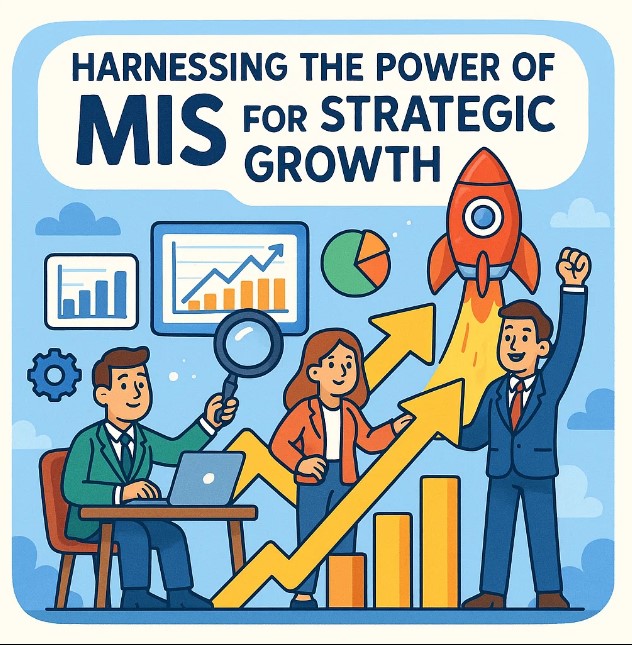
Harnessing the Power of MIS for Strategic Growth
In today’s fast-paced business environment, organizations are constantly striving to maintain a competitive edge. One of the most effective ways to achieve this is by leveraging Management Information Systems (MIS) to streamline operations, enhance decision-making, and drive strategic growth. MIS provides businesses with the tools needed to process vast amounts of data and turn them into actionable insights, enabling leaders to make informed decisions that propel the company forward.
Harnessing the power of MIS means empowering your business with real-time insights, automation, and scalable solutions. It's the key to unlocking strategic growth and maximizing performance at every level.
What is MIS?
Management Information Systems (MIS) are integrated systems designed to collect, process, store, and disseminate information within an organization. They play a vital role in facilitating the efficient management of business operations, providing real-time data that supports decision-making at all levels of the organization.
MIS can include a variety of components such as:
- Data collection and analysis tools
- Software systems to manage workflows and resources
- Reporting mechanisms that deliver insights to managers and executives
- Dashboards to present key performance indicators (KPIs)
The Strategic Value of MIS
1. Improved Decision-Making
MIS enables decision-makers to access real-time, accurate, and relevant information. This enhances the strategic planning process and ensures that business decisions are grounded in data, rather than relying on gut feeling or incomplete information. By analyzing trends, forecasting future scenarios, and identifying potential risks, businesses can make proactive decisions that lead to growth.
2. Operational Efficiency
With the right MIS in place, organizations can automate routine tasks, streamline workflows, and optimize resource utilization. This leads to significant improvements in efficiency, reducing operational costs and freeing up resources that can be allocated to higher-value tasks. For example, automation of reporting allows executives to spend more time analyzing data and less time compiling it manually.
3. Data-Driven Insights
MIS provides businesses with the ability to consolidate data from various sources and generate comprehensive reports. By using Business Intelligence (BI) tools integrated into the MIS framework, businesses can uncover hidden patterns, customer preferences, and operational bottlenecks. These insights are invaluable when it comes to identifying new growth opportunities, improving products and services, and staying ahead of the competition.
4. Enhanced Collaboration and Communication
Modern MIS tools often include collaborative features that allow teams to share information, work together in real-time, and communicate more effectively. With a centralized system, all departments—whether marketing, sales, or finance—can access the same data, ensuring alignment across the business. This reduces misunderstandings and fosters a more cohesive approach to achieving organizational goals.
5. Scalability for Growth
As a business grows, so does the volume of data it generates. Traditional systems can quickly become overwhelmed, leading to inefficiencies and errors. MIS, however, is designed to scale with the business, allowing companies to easily handle larger volumes of data without compromising on performance. Whether you're entering new markets or expanding product lines, a robust MIS can support growth by adapting to the increasing demands of the organization.
6. Improved Customer Relationship Management (CRM)
By integrating MIS with CRM systems, businesses can enhance their ability to understand customer needs, personalize offerings, and deliver exceptional customer service. MIS provides valuable data that helps businesses anticipate customer behavior, predict demand, and tailor marketing efforts to specific customer segments, all of which contribute to stronger customer relationships and, ultimately, business growth.

Best Practices for Implementing MIS
To harness the full potential of MIS, businesses must adopt best practices that ensure the system is effective, efficient, and aligned with strategic goals:
- Integrate MIS with other business systems: Ensure that MIS seamlessly integrates with your Enterprise Resource Planning (ERP), Customer Relationship Management (CRM), and other critical business systems to provide a holistic view of operations.
- Invest in user training: Ensure that employees are well-trained on the system and understand how to interpret and act on the data it provides.
- Focus on data quality: Data is the backbone of MIS, so it’s essential to maintain high-quality, accurate, and relevant data.
- Use advanced analytics: Take advantage of analytics tools to not only monitor performance but also to forecast trends and identify growth opportunities.
- Stay flexible: As the business landscape changes, so too should your MIS. Choose scalable systems that can adapt to future business needs.
Conclusion
Harnessing the power of MIS for strategic growth allows businesses to operate more efficiently, make better decisions, and drive innovation. As companies strive to stay competitive in an ever-changing environment, leveraging MIS will provide them with the tools needed to not only respond to challenges but also anticipate and capitalize on future opportunities. Whether you’re aiming for operational excellence or looking for new avenues for growth, a well-implemented MIS can be a powerful enabler of success.
How can leveraging MIS help your business unlock new growth opportunities and drive smarter decision-making?
